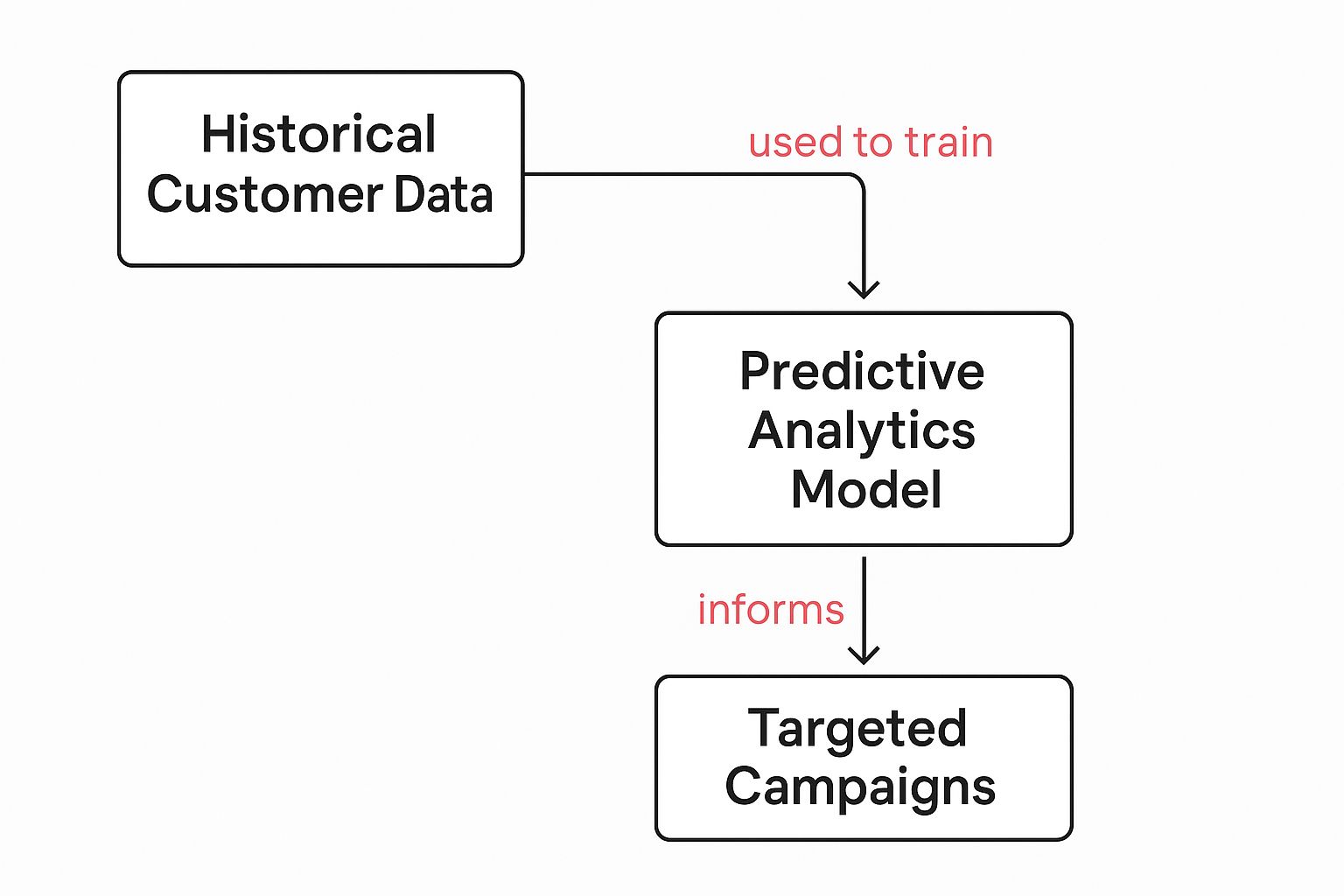Table of Contents
Decoding Predictive Analytics: Your Marketing Crystal Ball
Imagine knowing what your customers crave even before they realize it themselves. That’s the potential of predictive analytics in marketing. It’s like having a sneak peek into the future, allowing you to anticipate trends and customer behaviors. This shift from reacting to proacting is changing how businesses connect with their audience, enabling smarter decisions and optimized campaigns for maximum impact.
This infographic illustrates how data flows through predictive analytics for marketing:

Notice how historical customer data is the foundation. This data feeds the predictive analytics model, which generates valuable insights for highly targeted campaigns. This data-driven approach empowers you to personalize messages and offers, reaching the right people at the right moment with the right content. Forget the old “spray and pray” method – predictive analytics offers precision and efficiency, maximizing your marketing ROI.
Understanding the Predictive Power of Data
Predictive analytics isn’t magic; it’s about using data intelligently. It involves analyzing past customer behavior, demographics, purchase history, and other relevant information to uncover hidden patterns and trends. Think of it like a detective piecing together clues to solve a mystery. These patterns inform predictive models, which are essentially algorithms designed to forecast future outcomes. For example, a predictive model could analyze website browsing behavior to pinpoint visitors most likely to buy.
This screenshot from Wikipedia illustrates the conceptual framework of predictive analytics:

The image highlights the cyclical nature of predictive analytics, emphasizing the importance of continuous evaluation and refinement. The process involves defining your business objective, preparing data, building the model, deploying it, and then monitoring its performance to make necessary tweaks. This iterative approach ensures that the predictive models stay accurate and relevant as customer behavior and market conditions shift. This constant learning is key to successful predictive analytics.
Why Predictive Analytics Matters in Marketing
Predictive analytics has become essential for marketers, with many companies making significant investments in this field. By 2025, 40% of marketers expect to prioritize predictive analytics, indicating a substantial move towards using data to predict customer behavior and campaign outcomes. Learn more about the future of marketing campaigns here. The makeinfluencer blog also offers valuable insights on marketing and AI. This growing adoption emphasizes the power of predictive analytics in today’s competitive marketplace. It enables marketers to:
- Personalize Customer Experiences: Craft targeted messages and offers that resonate with individual customers.
- Optimize Marketing Spend: Allocate budget efficiently by focusing on high-potential customers and channels.
- Improve Conversion Rates: Boost sales by identifying and nurturing leads most likely to convert.
- Reduce Customer Churn: Proactively address customer issues and prevent them from leaving.
To further illustrate the shift, let’s look at a comparison table:
Traditional Marketing vs. Predictive Marketing Approaches
A side-by-side comparison showing how predictive analytics transforms traditional marketing practices
| Marketing Activity | Traditional Approach | Predictive Approach | Key Benefits |
|---|---|---|---|
| Campaign Targeting | Broad demographics | Specific customer segments based on predicted behavior | Improved ROI, reduced wasted ad spend |
| Messaging | Generic, one-size-fits-all | Personalized, tailored to individual preferences | Increased engagement and conversions |
| Offer Optimization | Standard promotions | Customized offers based on predicted purchase likelihood | Higher conversion rates, increased customer lifetime value |
| Customer Retention | Reactive, addressing churn after it occurs | Proactive, identifying at-risk customers and implementing preventative measures | Reduced churn, improved customer loyalty |
This table highlights how predictive analytics brings a more focused and personalized approach to various marketing activities. By anticipating future behavior, marketers can create more effective campaigns and build stronger customer relationships.
Predictive analytics empowers marketers to ditch the guesswork and embrace data-driven decisions that deliver real results. It’s not just about understanding the past; it’s about predicting the future and taking proactive steps to shape it.
How AI Powers Your Marketing Predictions
Imagine AI as your dedicated marketing analyst, tirelessly combing through mountains of data. This tireless assistant has perfect recall and never clocks out, giving you a continuous edge. That’s the foundation of predictive analytics for marketing: using AI-powered analysis to anticipate the future. AI algorithms delve into customer behavior patterns, past purchases, and how they interact with your brand to forecast their next moves with surprising accuracy.

This screenshot showcases TensorFlow, Google’s open-source library. It’s a popular choice for building and training the machine learning models that power predictive analytics. These models are the engine behind analyzing complex data and generating accurate predictions, making advanced AI accessible to businesses of all sizes.
From Simple Rules to Smart Systems
Predictive analytics in marketing has come a long way. Think back to the early days of simple “if-then” rules: “If a customer abandons their cart, then send a reminder email.” Basic, but effective to a point. Today’s AI-powered systems are far more sophisticated. They use machine learning to constantly learn from data, refining their predictive abilities over time. You might also be interested in: Check out our guide on influencer marketing ROI.
Unmasking the Power of Machine Learning
Machine learning algorithms are like expert detectives, uncovering subtle patterns that even seasoned marketers might miss. They analyze massive datasets, finding hidden connections between different factors. For instance, the system might discover that a certain combination of web browsing and email engagement strongly suggests a high-potential customer. This insight allows you to personalize marketing campaigns and focus your efforts where they’ll have the biggest impact.
Neural Networks: Mimicking the Human Brain
Taking things even further, advanced AI uses neural networks. These complex algorithms are designed to mirror the human brain’s information processing power. Neural networks can handle incredibly complex data and make highly nuanced predictions. Think of predicting the perfect moment to send a promotional email based not just on past engagement and purchases, but even the customer’s current location. That level of personalized targeting is transformative. This growth in predictive analytics is intertwined with advances in artificial intelligence. Looking ahead to 2025, 92% of businesses plan to invest in generative AI within the next three years, demonstrating a strong belief in AI’s power to reshape marketing. Discover more insights here.
This constant learning and improvement is what makes AI-powered predictive analytics so valuable. By anticipating customer needs and behaviors, businesses can create more effective campaigns, personalize customer experiences, and ultimately, achieve better results.
Essential Techniques That Actually Work
Let’s explore how predictive analytics can boost your marketing efforts. Think of it as a toolbox filled with powerful instruments. We’ll focus on three key techniques: Customer Lifetime Value (CLV) prediction, churn analysis, and lead scoring. Each offers a unique lens to understand your customers and fine-tune your strategies.
Predicting Customer Lifetime Value
Imagine having a crystal ball that shows you the total revenue each customer will bring in throughout their relationship with your brand. That’s essentially what CLV prediction does. Using historical data like purchase frequency, average order value, and how long a customer has been with you, it forecasts future revenue.
This allows you to segment customers based on their potential value. You can then tailor your marketing accordingly. Think about investing more in high-value customers while optimizing acquisition costs for others.
Churn Analysis: Your Early Warning System
Customer churn, or the rate at which customers leave, is a vital metric for any business. Churn analysis, using the power of predictive analytics, acts like an early warning system.
By examining past customer behavior, it identifies patterns suggesting a customer might be about to leave. Maybe they’ve stopped opening your emails, haven’t purchased recently, or have contacted customer support with complaints. These insights enable you to step in proactively—offering personalized incentives, resolving their issues, or providing extra support—before they decide to go elsewhere.
Lead Scoring: Turning Guesswork into Precision
Traditional sales funnels often involve a lot of guesswork. Lead scoring brings precision to this process. By analyzing data like demographics, website activity, email engagement, and social media interactions, predictive models assign scores to each lead.
These scores indicate the likelihood of a lead becoming a paying customer. This helps sales teams prioritize, personalize their outreach to high-scoring leads, and close deals more effectively.
To illustrate the technical side, let’s look at Scikit-learn, a powerful Python library for machine learning.
Scikit-learn offers a variety of algorithms frequently used in predictive analytics, including those we’ve discussed. Its user-friendly design and comprehensive documentation make it a valuable tool for data scientists of all levels. For enhancing marketing predictions, consider leveraging various AI tools for ecommerce.
Choosing the Right Technique
The best technique depends on your business model and objectives. CLV prediction is crucial for subscription services and businesses focused on retention. Churn analysis is essential for companies with high customer turnover. Lead scoring is invaluable for those with complex sales cycles who need to qualify leads efficiently.
To help you visualize the different techniques, their applications, and data needs, let’s look at this table:
Predictive Analytics Techniques and Applications
Overview of key predictive techniques with their marketing applications and data requirements
| Technique | Primary Use Case | Data Required | Implementation Difficulty | Expected ROI |
|---|---|---|---|---|
| CLV Prediction | Identifying high-value customers for targeted marketing | Historical transaction data, customer demographics | Medium | High (Improved customer retention, increased revenue) |
| Churn Analysis | Proactive intervention to prevent customer churn | Customer engagement data, support interactions, purchase history | Medium to High | High (Reduced churn rate, increased customer lifetime value) |
| Lead Scoring | Prioritizing and qualifying leads for sales outreach | Demographics, website activity, email engagement, social media interactions | Medium | High (Improved lead conversion rates, increased sales efficiency) |
This table summarizes the key applications and data requirements for each technique, helping you choose the right approach for your specific marketing challenges.
Data Requirements and Timelines
Each technique has its own data needs and implementation timelines. CLV prediction typically requires historical transaction data. Churn analysis relies on customer engagement and support data. Lead scoring uses a broader dataset, from demographics to online behavior. Implementing these techniques can range from weeks to months, depending on your data infrastructure and model complexity. Start with clear goals and realistic expectations. By understanding the strengths of each technique, you can choose the right tool to tackle your unique marketing challenges, whether it’s boosting email open rates, optimizing ad spend, or lowering customer acquisition costs.
Success Stories That Prove It Works
Real-world examples truly highlight the power of predictive analytics in marketing. Let’s explore how businesses, both large and small, use this technology to achieve impressive results. Think about Netflix. They don’t just suggest movies; they use predictive analytics to figure out what original series to create, investing millions based on what their algorithms tell them.
Similarly, Amazon’s recommendation engine doesn’t stop at suggesting products. It predicts what people will want so accurately that they can position inventory strategically before customers even start searching.

This screenshot of Netflix’s homepage shows their personalized recommendation system, a perfect example of predictive analytics at work. Every recommendation is based on what the user has watched before, showing how these systems learn individual preferences to improve user experience and keep people engaged.
Big Results, Not Just Big Budgets
While Netflix and Amazon are huge companies, you don’t need their resources to benefit from predictive analytics. Many mid-sized companies have seen great results with focused strategies. For instance, one B2B company completely changed its lead generation process. By using predictive models to identify high-potential prospects, they saw a 30% increase in qualified leads. This helped their sales team focus their efforts and close deals faster.
From E-Commerce to Service: A Wide Range of Applications
E-commerce businesses have also seen impressive results with predictive analytics. One online retailer used predictive models to personalize product recommendations, which led to a 2x increase in conversion rates. This shows how understanding customer needs beforehand leads to more purchases. Even service-based companies are getting in on the action, using churn prediction to identify customers who are likely to leave and then taking steps to keep them happy. This often leads to lower churn rates and better customer retention. For more on managing influencer relationships, check out our guide here.
Real-World Case Studies: Learning From Others’ Experiences
To give you some practical examples, we’ll look at detailed case studies showing the benefits of predictive analytics in marketing. These studies will highlight particular challenges, the predictive models used, and the actual results. You’ll see quantifiable metrics, how long implementation took, and honest discussions about the hurdles these businesses overcame. This realistic view sets accurate expectations for adding predictive analytics into your own marketing efforts. Solid techniques are essential for success. Knowing how to create a strong digital marketing strategy is also vital.
Measuring Success: Metrics That Matter
These success stories show the real value of predictive analytics. They offer concrete evidence of more leads, higher conversion rates, and lower churn, instead of just making general promises. By looking at real-world applications, you’ll get a better idea of how predictive analytics can impact your own marketing efforts.
Building Your Implementation Roadmap
Moving from the theoretical aspects of predictive analytics to actually using it in your marketing strategy requires a structured approach. Think of it like planning a road trip: you wouldn’t just jump in the car and start driving, would you? You’d map out your route, identify key stops, and pack accordingly. This roadmap will be your guide, helping you navigate from assessing your current data landscape to choosing the right tools and demonstrating early value.

This screenshot showcases Salesforce Einstein, an AI-powered platform that seamlessly integrates predictive analytics directly into your existing CRM workflows. Think of it as having a super-intelligent assistant working behind the scenes, analyzing your data and offering helpful suggestions. The focus on predictive lead scoring and opportunity insights shows how these powerful capabilities can be embedded within your everyday sales and marketing processes. This means you can start using predictive insights without needing to implement separate, complex systems.
Assessing Your Current State
Before diving headfirst into implementation, it’s crucial to take stock of your existing data infrastructure. It’s like checking your supplies before a hike – making sure you have everything you need. This involves a few key steps:
- Data Audit: Identify the data you’re currently collecting, its quality, and how easy it is to access. This audit will illuminate what data you can use immediately and where you might have gaps. Imagine it as taking inventory of your pantry before cooking a big meal.
- Capability Assessment: Honestly evaluate your team’s current analytical skills. Are there any training needs? Building internal expertise is essential for long-term success. It’s like making sure your team has the right skills before tackling a challenging project.
- Quick Wins: Look for areas where predictive analytics can deliver fast, demonstrable results. Early successes are vital for building stakeholder confidence and securing buy-in for more ambitious initiatives. These quick wins are like appetizers, building excitement for the main course.
Building Your Team and Securing Resources
Implementing predictive analytics successfully requires a collaborative effort. It’s like assembling a team of experts for a complex mission. Successful marketing leaders focus on these key steps:
- Cross-Functional Teams: Bring together a team with members from various departments, including marketing, IT, sales, and data science. This diverse perspective ensures a holistic approach, like having different specialists contribute to a patient’s care.
- Budget Allocation: Clearly outline the necessary resources and explain the investment to leadership. Focus on the potential return on investment (ROI) of predictive analytics to gain their support. It’s like presenting a business case for a new project.
- Realistic Timelines: Develop a phased implementation plan with achievable milestones. Acknowledge potential roadblocks and build in some buffer time for unexpected delays. This helps avoid disappointment and keeps everyone on track.
Choosing the Right Tools
Choosing the right tools depends on your budget and your specific needs. Just like choosing the right equipment for a camping trip – you need to consider what you’ll be doing and how much you can spend. This selection process involves:
- Platform Evaluation: Compare different analytics platforms. Consider factors like how easy they are to use, their integration capabilities, and whether they can scale with your business.
- Budget Considerations: Explore both basic analytics tools and more advanced enterprise-level solutions, choosing options that align with your financial resources. Starting small and scaling up as needed is often a smart approach.
- Pilot Projects: Test different tools on a smaller scale before committing to a full implementation. This lets you evaluate their effectiveness and identify any limitations beforehand. It’s like taking a test drive before buying a car.
Managing Expectations and Demonstrating Value
Successfully implementing predictive analytics also involves managing expectations and demonstrating value. It’s about showing the benefits of your “road trip” to everyone involved. These best practices will help:
- Clear Communication: Keep stakeholders informed about your progress, challenges, and expected outcomes. Transparency builds trust and reinforces support.
- Early Value Demonstration: Highlight initial wins and showcase how predictive analytics directly contributes to your marketing objectives. Tangible results validate the investment.
- Continuous Optimization: Establish a process for ongoing evaluation and refinement. As your data evolves and your business goals change, adapt your predictive models accordingly.
By following this roadmap, you can build a solid foundation for predictive analytics, empowering you to make data-driven decisions, personalize customer experiences, and ultimately, achieve measurable marketing success.
Proving ROI and Measuring What Matters
The real test of any predictive analytics program isn’t just about using cool technology. It’s about showing how it boosts your business and makes the investment worthwhile. This means demonstrating its value in a way that resonates with decision-makers. Think of it like proving a new marketing campaign works – you need solid results. This section explores how to build measurement frameworks that showcase this value, moving beyond surface-level metrics and focusing on what truly impacts revenue.
Identifying Key Performance Indicators
Forget “likes” and “follows.” In predictive analytics for marketing, we need Key Performance Indicators (KPIs) tied to actual business growth. Think of them as the vital signs of your marketing health. These KPIs will vary based on the predictive model you’re using, just like different medical tests measure different aspects of your health. For example:
- Lead Scoring Models: Imagine having a crystal ball telling you which leads are most likely to become customers. Lead scoring does just that. Here, focus on conversion rates. Are more of those high-potential leads becoming paying customers?
- Churn Prediction Models: Think of this as preventative care for your customer base. You’re identifying at-risk customers before they leave. Track improvements in customer retention rates. Are you keeping those valuable customers happy and engaged?
- Product Recommendation Engines: This is like having a personal shopper for every customer. Monitor shifts in average order value and sales revenue. Are customers adding more to their carts or buying more often?
Read also: User-Generated Content Strategy
By carefully monitoring these KPIs, you create a clear picture of how predictive analytics impacts your bottom line. It’s like tracking your fitness progress – you need to see how your efforts are paying off.
Building a Compelling Business Case
Getting good results is only half the battle. You need to present them effectively. Think of it like pitching a new idea – you need to get buy-in. Here’s how to communicate the value of your predictive analytics program to leadership:
- Focus on Outcomes: Don’t just show numbers; explain what they mean. If conversions increased, how did that impact revenue? Did reducing churn save money?
- Use Visualizations: A picture is worth a thousand words, especially with data. Graphs and charts make it easy for stakeholders to see the impact at a glance.
- Tell a Story: Data is more compelling when it’s part of a narrative. Use real examples to show how predictive analytics made a difference.
- Provide Context: Comparing your results to industry averages or past performance helps demonstrate the real improvement you’ve achieved.
This screenshot from Google Analytics shows how you can visualize key data. While this example shows website traffic, you can customize it to track metrics specific to your predictive models. Real-time monitoring lets you continuously optimize your campaigns, reacting to changes as they happen.
While predictive analytics is powerful, proving its ROI remains a challenge for many marketers. In fact, 63% consider ROI their top metric. This highlights the importance of showing how your work contributes to the bottom line. (Source)
Addressing Attribution Challenges
Figuring out which marketing efforts actually lead to sales (attribution) is a common marketing headache. Predictive analytics can help untangle this mess. By analyzing customer interactions across different channels, predictive models give a clearer view of each touchpoint’s contribution to a conversion. This data-driven approach empowers smarter budget allocation decisions.
Continuous Optimization
Predictive analytics isn’t a one-time fix. Customer behavior and market trends constantly change, just like the weather. To stay effective, your models need ongoing attention:
- Regularly Retrain Your Models: Fresh data keeps predictions accurate. Set a schedule for retraining your models with updated information, just like updating software for optimal performance.
- Monitor Performance: Regularly check your KPIs for any signs of declining effectiveness. It’s like a regular checkup to catch potential issues early.
- Experiment with New Techniques: The field of predictive analytics is always advancing. Stay informed about new techniques and test them to see if they can enhance your results.
By following these strategies, your predictive analytics program will not only deliver tangible results but also gain the continuous support of leadership. It’s about showing the value, not just talking about it.
To keep track of everything, consider using a table like the one below:
Key Performance Indicators for Predictive Analytics Programs
Essential metrics to track the success and ROI of your predictive analytics initiatives
| KPI Category | Specific Metrics | Measurement Method | Target Improvement |
|---|---|---|---|
| Lead Generation | Conversion Rate | Track leads that convert to customers. Compare against baseline before predictive analytics. | Increase by 10-15% |
| Customer Retention | Churn Rate | Monitor the percentage of customers who cancel their service or subscription. | Decrease by 5-10% |
| Sales Performance | Average Order Value | Calculate the average value of each customer transaction. | Increase by 5-10% |
| Sales Performance | Revenue Growth | Track the overall increase in sales revenue attributed to predictive analytics. | Increase by 10-20% |
This table helps organize your KPIs and track progress towards your goals. It provides a concise snapshot of the impact of your predictive analytics program, making it easier to communicate success to stakeholders. Regularly reviewing these metrics will help you stay on track and ensure you’re getting the most out of your investment in predictive analytics.
Your Next Steps to Predictive Marketing Success
So, we’ve covered a lot about predictive analytics. Now, how do you actually use it? Let’s create a practical roadmap—no abstract theories here—to help you integrate predictive analytics into your daily marketing operations. Think of this as your action plan, built on the real-world experiences of marketers who have already made this shift.
Prioritizing Your Predictive Toolkit
It’s important to remember that different predictive techniques require different levels of resources, like data and expertise. We’ll help you figure out which techniques make the most sense to start with, based on what you already have and what you’re aiming for. For example, if you’re already collecting detailed customer transaction data, predicting Customer Lifetime Value (CLV) might be a great first step. If high customer turnover is keeping you up at night, churn analysis could be your top priority.
This isn’t a one-size-fits-all situation. It’s about choosing the right tools for your specific challenges and opportunities. We’ll guide you through that process so you can score some early wins and build momentum.
Actionable Checklists for Implementation
To keep things practical, we’ll provide actionable checklists for each step of implementation. These checklists break down big, complicated processes into smaller, manageable tasks—from prepping your data to choosing and deploying the right models. They’re designed to keep you organized and on track so you don’t get lost in the details.
Imagine these checklists as your step-by-step instruction manual, making sure you don’t miss any crucial details. They’ll keep you focused and help you make steady progress toward your goals.
Resources for Continued Learning
Predictive analytics is a dynamic field, always changing. We’ll connect you with valuable resources like articles, tutorials, and online communities to keep you learning and up-to-date. This continuous learning is key to adapting to market shifts and making sure your predictive analytics program stays effective in the long run.
Setting Realistic Expectations and Staying Motivated
Let’s be real: implementing predictive analytics takes time and work. We’ll help you set reasonable expectations by providing realistic timelines and giving you honest insights into the bumps you might hit along the way. Knowing what to expect will help you stay resilient and motivated.
More importantly, we’ll keep reminding you of the real, tangible competitive advantages predictive analytics brings to marketing teams that embrace data-driven decisions. These advantages make all the effort worthwhile. By focusing on these benefits, you’ll stay engaged with the long-term potential of predictive analytics and keep a clear picture of what success looks like.
Ready to transform your marketing with the power of creators? JoinBrands provides the platform and network you need to connect with over 250,000 creators, streamline your campaigns, and achieve measurable results. Discover how JoinBrands can elevate your marketing strategy.






